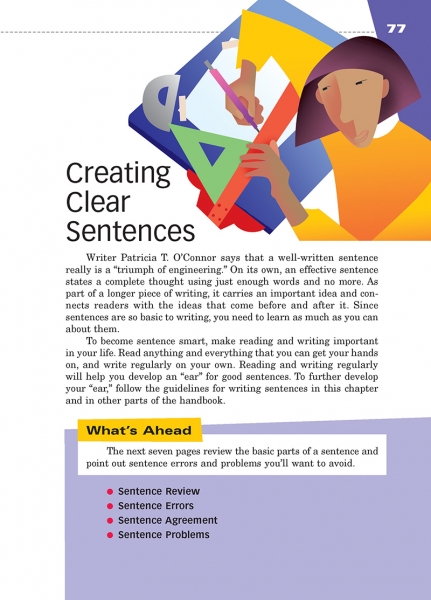Page 077 from

Start-Up Activity
Torment your students with sentence fragments. After the bell has rung and they are all seated, get their attention and begin class with the following fragment:
"When I created your next test"
Then just stand there. Your students will stare at you quizzically. More assertive students may ask, "Yeah? When you created our next test, what?" Answer using another fragment.
"One hundred questions"
Again, you should be greeted with confused stares. "What about one hundred questions?"
"A curve"
"What about a curve?" they will ask in exasperation. Finally, you can let them in on the problem: "I've been speaking to you in sentence fragments. They are not complete thoughts, which is why they are so aggravating. You want the rest of the sentence so you know what I am talking about. That's how important sentences are. They are the smallest form of a complete thought. Getting them right lets you communicate with your reader. Getting them wrong leaves everyone confused and annoyed.
"By the way, on your next test, a hundred questions, a curve"
Your students will be very dismayed by this final fragment, which will help you teach them the importance of complete sentences.
Think About It
“Fix this sentence: He put the horse before the cart.”
—Stephen Price

Start-Up Activity
Torment your students with sentence fragments. After the bell has rung and they are all seated, get their attention and begin class with the following fragment:
"When I created your next test"
Then just stand there. Your students will stare at you quizzically. More assertive students may ask, "Yeah? When you created our next test, what?" Answer using another fragment.
"One hundred questions"
Again, you should be greeted with confused stares. "What about one hundred questions?"
"A curve"
"What about a curve?" they will ask in exasperation. Finally, you can let them in on the problem: "I've been speaking to you in sentence fragments. They are not complete thoughts, which is why they are so aggravating. You want the rest of the sentence so you know what I am talking about. That's how important sentences are. They are the smallest form of a complete thought. Getting them right lets you communicate with your reader. Getting them wrong leaves everyone confused and annoyed.
"By the way, on your next test, a hundred questions, a curve"
Your students will be very dismayed by this final fragment, which will help you teach them the importance of complete sentences.
Think About It
“Fix this sentence: He put the horse before the cart.”
—Stephen Price

